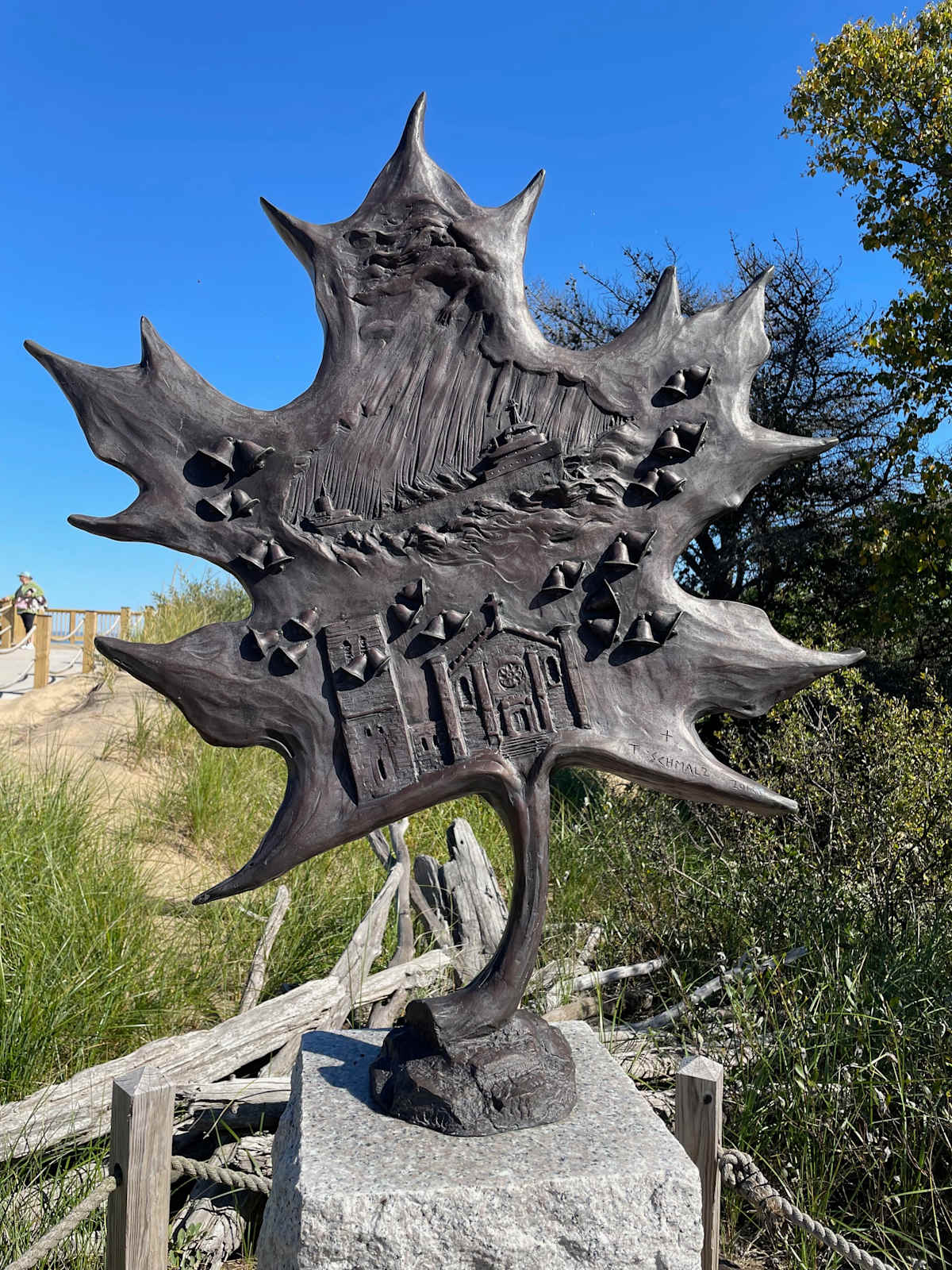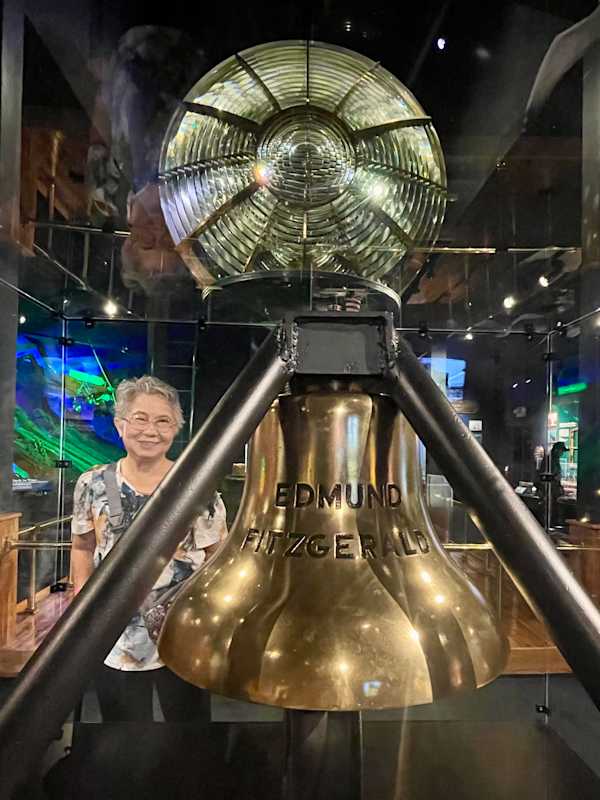Verse 1: Hum or singalong
The legend lives on from the Chippewa on down
Of the big lake they called Gitche Gumee.
The lake, it is said, never gives up her dead
When the skies of November turn gloomy.
With a load of iron ore twenty-six thousand tons more
Than the Edmund Fitzgerald weighed empty,
That good ship and true was a bone to be chewed
When the gales of November came early.
The Wreck of the Edmund Fitzgerald
There is nothing like a trip to Lake Superior and the upper peninsula of Michigan to get you humming Gordon Lightfoot’s great ballad – The Wreck of the Edmund Fitzgerald. Its haunting melody tells a vivid story of that ship’s demise in seven lengthy verses. The song topped the music charts in both the United States and Canada in 1976, when it was released – a year after the Edmund Fitzgerald sank to the bottom of Lake Superior.
During our recent vacation in Michigan, my wife and I visited the Great Lakes Shipwreck Museum, which is located on the shoreline of Lake Superior at Whitefish Point, which overlooks Whitefish Bay. The museum is located 17 miles southeast of where the Edmund Fitzgerald was lost on November 10, 1975. The big freighter still lies there today – 535 feet below the surface of the lake.
On the way to our car, after leaving the museum, I reminded my wife of the song that Lightfoot wrote. The melody was vaguely rattling around in my brain; I think it had been faintly playing in the museum. My wife couldn’t remember the song, and she asked me how it went. In response to her query, I hummed and sang a few botched lyrics, which didn’t help her remember but apparently entertained another couple also heading for their car. As we drove away, we found the song on YouTube and my wife instantly remembered it (so much for my humming skills); and the song became engrained in my brain, repeating itself during the remainder of our vacation.
On the next day, while visiting the Museum Ship Valley Camp in Sault Ste. Marie, we saw what remained of one of the Edmund Fitzgerald’s lifeboats, which had been destroyed by the storm; and some buoys that marked the site of the wreckage, which were crushed when they were pulled well below the surface by a subsequent storm. Lightfoot’s song was still running through my mind and (I think) the museum ship’s sound system.
Verse 5: Hum or singalong
Does anyone know where the love of God goes
When the waves turn the minutes to hours?
The searchers all say they’d have made Whitefish Bay
If they’d put fifteen more miles behind her.
They might have split up or they might have capsized;
They may have broke deep and took water.
And all that remains is the faces and the names
Of the wives and the sons and the daughters.
Whitefish Bay
If you look at a map of Lake Superior, you will note that a very big and wide lake funnels down to a point on the eastern side of the lake. The funnel is Whitefish Bay, and the point is the lock system at Sault Ste. Marie. As such, maritime traffic gets more congested as the great ships move towards Lake Huron. That is Danger #1. The second danger involves the 200-350 miles of water to the west of Whitefish Bay. When the winds start to blow from the west, northwest, or north, there is nothing over that expanse to stop terrific seas and waves from forming. And lasty, there are the visibility issues that often come with fog or heavy “lake-effect” snowstorms – that can cut visibility to near zero at times. That is why Whitefish Bay is sometimes referred to as Lake Superior’s graveyard.
The Wreck of the Edmund Fitzgerald Memorial Monument by T. Schmalz
At the beginning of this article, you will find a photograph of a monument that is located at the starting point of a boardwalk that leads from the Great Lakes Shipwreck Museum’s buildings to the shoreline at Whitefish Point. The monument can be easily overlooked by those in a hurry to reach the waters of the bay. It appears at first to be a maple leaf with the characteristic sharp edges and stem of such leaves. When I viewed it more closely, I found it to be one of the best monuments that I had ever seen. It was not a leaf; it was a memorial to the Edmund Fitzgerald. Take a little time and zoom in on the details.
The monument has a very threatening look – something of an ogre’s face with flailing limbs. The little fingers give the storm a human quality. In the middle you will notice the Edmund Fitzgerald being tossed about amongst sheets of rain and heavy waves. At the bottom of the memorial is what Lightfoot called the Maritime Sailor’s Cathedral (more later). And sprinkled throughout the rest of the memorial are 29 bells – representing the 29 mariners who were killed when the Edmund Fitzgerald sank – and the 29 bells that later tolled for their lives at the Maritime Sailor’s Cathedral (more later).
Verse 2: Hum or singalong
The ship was the pride of the American side
Coming back from some mill in Wisconsin.
As the big freighters go, it was bigger than most,
With a crew and good captain well seasoned.
Concluding some terms with a couple of steel firms
When they left fully loaded for Cleveland.
And later that night when the ship’s bell rang
Could it be the north wind they’d been feelin’?
The Ship’s Bell
On July 4, 1995, the 195-pound bronze ship’s bell was raised over 500 feet from the bottom of Lake Superior. It was recovered at the request of family members who desired a memorial for their loved ones at Whitefish Point. Many of those relatives were present when the bell surfaced – possibly bringing some sort of closure for them after 20 years. That bell is pictured below. It now resides in the Great Lakes Shipwreck Museum. On that same day, July 4, 1955, a replica bell, inscribed with the names of the 29 that were killed was lowered and secured to the sunken ship where the original bell had been. This inscribed bell now serves as a permanent grave marker.
Verse 7: Hum or singalong
In a musty old hall in Detroit they prayed
In the Maritime Sailor’s Cathedral.
The church bell chimed till it rang twenty-nine times
For each man on the Edmund Fitzgerald.
The legend lives on from the Chippewa on down
Of the big lake they call Gitche Gumee.
Superior, they said, never gives up her dead
When the gales of November come early.
The Maritime Sailor’s Cathedral / Mariners’ Church
Lightfoot’s lyrics called it the “Maritime Sailors’ Cathedral;” it was in fact a reference to Mariners’ Church, the Detroit church founded in 1842 as a place of worship for sailors. Years later, Lightfoot visited that church, prompting him to change the lyrics of the song, that he subsequently performed, from “musty” to “rustic.” Lightfoot died on May 1, 2023, in Toronto, at age 84. On the following day Mariners’ Church of Detroit honored Lightfoot by ringing its bell a total of 30 times – the final bell for Lightfoot himself.
A Final Word
The weather was beautiful on September 28, 2025, when we visited Whitefish Bay. As I walked along the shore it was hard to imagine the storm that sank the Edmund Fitzgerald. The 50th anniversary of the ship’s sinking is just sixteen days from now. Ice formations on these fresh-water Great Lakes close the Sault St. Marie locks every winter; and there is always some pressure to get one more load of taconite or grain through the locks before the shipping season ends. Sometimes the weather gets dicey; maritime shipping has its inherent dangers. Thus, the prayers – from the “Maritime Sailor’s Cathedral” or wherever maritime sailors and their families live and worship.
It was fitting that the Mariners’ Church rang a 30th bell for Gordon Lightfoot on the day after his death. While the ship’s sinking was horrific, this maritime tragedy might have been lost to our collective national story, if it had not been for his soulful ballad – the kind you can’t stop humming.
His melody continued to haunt me on the days after we left Whitefish Bay. It was stuck in my head. I couldn’t shake it until we later headed west on Interstate 80 through Iowa. It was a windy day, with those winds blowing from the south. Occasionally a tumbleweed would blow across the road in front of me and my brain temporarily switched to “Tumbling Tumbleweeds,” Sing along with me:
“... Drifting along with the tum-bull-in tumbleweeds.”

